RFID Unpacked: A Case Study in Employing RFID Tags from Item to Pallet Level
Abstract
1. Introduction
2. Materials and Methods
2.1. Literature Review to Define the Knowledge Gap and Best Strategy
2.2. RFID-Tagged Consumer Products
2.3. Passive UHF RFID Tags
2.4. Brady HH85 RFID Handheld Scanner
2.5. Synergy5 Stretch Wrapping System
2.6. RFID Readability Assessment at Different Packaging Levels
2.6.1. Phase 0: Inspection
2.6.2. Phase 1: Reading Distance and Reader Position at Case Level
2.6.3. Phase 2: Item Configuration at the Case Level
2.6.4. Phase 3: Layer Level Item Configuration
2.6.5. Phase 4: Height and Distance at the Pallet Level
2.7. Rotating Table Tests
2.8. Statistical Analysis
3. Results and Discussion
3.1. Phase 1: The Effect of Reader Distance and Position on RFID Readability at the Case Level
3.2. Phase 2: The Effects of Item Configuration Within a Case on RFID Readability
3.3. Phase 3: The Effect of Configuration of the Layers in a Pallet on RFID Readability
3.4. Phase 4: The Effect of Reader Height at Pallet Level on RFID Readability
3.5. General Comparison of Tag 1 and Tag 2
3.6. Additional Testing to Improve the Overall Readability at the Pallet Level: The Impact of Rotation
4. Conclusions
Author Contributions
Funding
Data Availability Statement
Acknowledgments
Conflicts of Interest
References
- Nizioł, M.; Jankowski-Mihułowicz, P.; Węglarski, M. Determination of Parameters of Radio Frequency Identification Transponder Antennas Dedicated to IoTT Systems Located on Non-Planar Objects. Electronics 2024, 13, 2800. [Google Scholar] [CrossRef]
- Li, Y.; Ma, Y.; Tian, C.; Su, D.; Yang, B. DNCL: Hybrid DOA Estimation and NMDS Cooperative Multi-Target Localization for RFID. Electronics 2023, 12, 1742. [Google Scholar] [CrossRef]
- Song, C.; Wu, Z.; Gray, J.; Meng, Z. An RFID-Powered Multisensing Fusion Industrial IoT System for Food Quality Assessment and Sensing. IEEE Trans. Ind. Inform. 2024, 20, 337–348. [Google Scholar] [CrossRef]
- Raj, A.; Mukherjee, A.A.; de Sousa Jabbour, A.B.L.; Srivastava, S.K. Supply chain management during and post-COVID-19 pandemic: Mitigation strategies and practical lessons learned. J. Bus Res. 2022, 142, 1125–1139. [Google Scholar] [CrossRef] [PubMed]
- Tian, S.; Wu, L.; Pia Ciano, M.; Ardolino, M.; Pawar, K.S. Enhancing innovativeness and performance of the manufacturing supply chain through datafication: The role of resilience. Comput. Ind. Eng. 2024, 188, 109841. [Google Scholar] [CrossRef]
- Khan, Y.; Su’ud, M.B.M.; Alam, M.M.; Ahmad, S.F.; Ahmad, A.Y.A.B.; Khan, N. Application of Internet of Things (IoT) in Sustainable Supply Chain Management. Sustainability 2022, 15, 694. [Google Scholar] [CrossRef]
- Bix, L.; Sansgiry, S.S.; Clarke, R.; Cardoso, F.; Shringarpure, G.S. Retailers’ tagging practices: A potential liability? Packag. Technol. Sci. 2004, 17, 3–11. [Google Scholar] [CrossRef]
- Hellström, D.; Saghir, M. Packaging and logistics interactions in retail supply chains. Packag. Technol. Sci. 2006, 20, 197–216. [Google Scholar] [CrossRef]
- Singh, S.P.; McCartney, M.; Singh, J.; Clarke, R. RFID research and testing for packages of apparel, consumer goods and fresh produce in the retail distribution environment. Packag. Technol. Sci. 2008, 21, 91–102. [Google Scholar] [CrossRef]
- Tao, F.; Wang, L.; Fan, T.; Yu, H. RFID Adoption Strategy in a Retailer-Dominant Supply Chain with Competing Suppliers. Eur. J. Oper. Res 2022, 302, 117–129. [Google Scholar] [CrossRef]
- Zohar, N. Divide and Conquer: Detecting and Tracking Passive RFID Tags in Retail Spaces. In Proceedings of the 2022 IEEE Wireless Communications and Networking Conference (WCNC), Austin, TX, USA, 10–13 April 2022; pp. 1443–1448. [Google Scholar]
- Casamayor-Pujol, V.; Gastón, B.; López-Soriano, S.; Alajami, A.A.; Pous, R. A Simple Solution to Locate Groups of Items in Large Retail Stores Using an RFID Robot. IEEE Trans. Ind. Inform. 2022, 18, 767–775. [Google Scholar] [CrossRef]
- Shen, E.; Duan, S.; Guo, S.; Yang, W. Object Localization and Sensing in Non-Line-of-Sight Using RFID Tag Matrices. Electronics 2024, 13, 341. [Google Scholar] [CrossRef]
- Wang, H.; Du, W.; Qin, B.; Pan, R.; Pang, S. A Real-Time System Status Evaluation Method for Passive UHF RFID Robots in Dynamic Scenarios. Electronics 2024, 13, 4162. [Google Scholar] [CrossRef]
- Chetouane, F. An Overview on RFID Technology Instruction and Application. IFAC-PapersOnLine 2015, 48, 382–387. [Google Scholar] [CrossRef]
- Claucherty, E.; Cummins, D.; Aliakbarian, B. Exploring the correlation between drug formulation and radio frequency performance in RFID-enabled pharmaceutical products. Int. J. RF Technol. 2024, 14, 33–52. [Google Scholar] [CrossRef]
- Kumar, P.; Reinitz, H.W.; Simunovic, J.; Sandeep, K.P.; Franzon, P.D. Overview of RFID technology and its applications in the food industry. J. Food Sci. 2009, 74, R101–R106. [Google Scholar] [CrossRef]
- Htun, N.N.; Wiśniewska, A.; Nocella, G.; Santa Cruz, E.; Peracaula-Moner, A.; Vehmas, K.; Hakola, L.; Liczmańska-Kopcewicz, K.; Bridgett, L.; Verbert, K. Smart tag packaging technologies: A qualitative investigation of consumers’ needs and expectations. Packag. Technol. Sci. 2023, 36, 595–613. [Google Scholar] [CrossRef]
- Ghaani, M.; Cozzolino, C.A.; Castelli, G.; Farris, S. An overview of the intelligent packaging technologies in the food sector. Trends Food Sci. Technol. 2016, 51, 1–11. [Google Scholar] [CrossRef]
- Zhang, J.; Tian, G.Y.; Marindra, A.M.J.; Sunny, A.I.; Zhao, A.B. A Review of Passive RFID Tag Antenna-Based Sensors and Systems for Structural Health Monitoring Applications. Sensors 2017, 17, 265. [Google Scholar] [CrossRef] [PubMed]
- Sriram, V.P.; Raj, K.B.; Srinivas, K.; Pallathadka, H.; Sajja, G.S.; Gulati, K. An Extensive Systematic Review of RFID Technology Role in Supply Chain Management (SCM). In Proceedings of the 2021 6th International Conference on Signal Processing, Computing and Control (ISPCC), Solan, India, 7–9 October 2021; pp. 789–794. [Google Scholar]
- Tan, W.C.; Sidhu, M.S. Review of RFID and IoT integration in supply chain management. Oper. Res. Perspect. 2022, 9, 100229. [Google Scholar] [CrossRef]
- Grunt, M.; Błażejewski, A.; Pecolt, S.; Królikowski, T. BelBuk System—Smart Logistics for Sustainable City Development in Terms of the Deficit of a Chemical Fertilizers. Energies 2022, 15, 4591. [Google Scholar] [CrossRef]
- Pan, C.; Liu, M. Optimization of Intelligent Logistics Supply Chain Management System Based on Wireless Sensor Network and RFID Technology. J. Sens. 2021, 2021, 8111909. [Google Scholar] [CrossRef]
- Chen, C.-L.; Lim, Z.-Y.; Liao, H.-C.; Deng, Y.-Y.; Chen, P. A Traceable and Verifiable Tobacco Products Logistics System with GPS and RFID Technologies. Appl. Sci. 2021, 11, 4939. [Google Scholar] [CrossRef]
- Tian, F. An agri-food supply chain traceability system for China based on RFID & blockchain technology. In Proceedings of the 2016 13th International Conference on Service Systems and Service Management (ICSSSM), Kunming, China, 24–26 June 2016; pp. 1–6. [Google Scholar]
- Kineber, A.F.; Oke, A.E.; Elseknidy, M.; Hamed, M.M.; Kayode, F.S. Barriers to the Implementation of Radio Frequency Identification (RFID) for Sustainable Building in a Developing Economy. Sustainability 2023, 15, 825. [Google Scholar] [CrossRef]
- Lui, A.K.H.; Lo, C.K.Y.; Ngai, E.W.T.; Yeung, A.C.L. A Tough Pill to Swallow? The Lessons Learned from Mandatory RFID Adoption. Int. J. Prod. Econ. 2023, 258, 108811. [Google Scholar] [CrossRef]
- Popova, I.; Abdullina, E.; Danilov, I.; Marusin, A.; Marusin, A.; Ruchkina, I.; Shemyakin, A. Application of the RFID technology in logistics. Transp. Res. Procedia 2021, 57, 452–462. [Google Scholar] [CrossRef]
- Ferdous, R.M.; Reza, A.W.; Siddiqui, M.F. Renewable energy harvesting for wireless sensors using passive RFID tag technology: A review. Renew. Sustain. Energy Rev. 2016, 58, 1114–1128. [Google Scholar] [CrossRef]
- Rozhok, A.; Adorni, E.; Revetria, R. Literature Review on Supply Chain Operations Reference Model. In Proceedings of the Modelling and Simulation 2023—European Simulation and Modelling Conference 2023, ESM 2023, Toulouse, France, 24–26 October 2023; pp. 383–388. [Google Scholar]
- Public Law 117–78 117th Congress, 135 STAT. 1525. An Act to Ensure That Goods Made with Forced Labor in the Xinjiang Uyghur Autonomous Region of the People’s Republic of China Do Not Enter the United States Market, and for Other Purposes. 23 December 2021. Available online: https://www.congress.gov/117/plaws/publ78/PLAW-117publ78.pdf (accessed on 9 June 2024).
- Public Law 113–54 113th Congress, 127 STAT. 587. An Act to Amend the Federal Food, Drug, and Cosmetic Act with Respect to Human Drug Compounding and Drug Supply Chain Security, and for Other Purposes. 27 November 2013. Available online: https://www.congress.gov/113/statute/STATUTE-127/STATUTE-127-Pg587.pdf (accessed on 9 June 2024).
- Brechtelsbauer, E.D.; Pennell, B.; Durham, M.; Hertig, J.B.; Weber, R.J. Review of the 2015 Drug Supply Chain Security Act. Hosp. Pharm. 2016, 51, 493–500. [Google Scholar] [CrossRef]
- Bapatla, A.K.; Mohanty, S.P.; Kougianos, E. PharmaChain 3.0: Efficient Tracking and Tracing of Drugs in Pharmaceutical Supply Chain Using Blockchain Integrated Product Serialization Mechanism. SN Comput. Sci. 2024, 5, 149. [Google Scholar] [CrossRef]
- Public Law 111–353 111th Congress, 124 STAT. 3885. An Act to Amend the Federal Food, Drug, and Cosmetic Act with Respect to the Safety of the Food Supply. 4 January 2011. Available online: https://www.govinfo.gov/content/pkg/PLAW-111publ353/pdf/PLAW-111publ353.pdf (accessed on 9 June 2024).
- Grover, A.K. Out of the frying pan and into the fire? Uncovering the impact of FSMA’s sanitary food transportation rule on the food logistics industry. Bus. Horiz. 2023, 66, 203–214. [Google Scholar] [CrossRef]
- Vahidi, A.; Gebremariam, A.T.; Di Maio, F.; Meister, K.; Koulaeian, T.; Rem, P. RFID-based material passport system in a recycled concrete circular chain. J. Clean. Prod. 2024, 442, 140973. [Google Scholar] [CrossRef]
- Walden, J.; Steinbrecher, A.; Marinkovic, M. Digital Product Passports as Enabler of the Circular Economy. Chem. Ing. Tech. 2021, 93, 1717–1727. [Google Scholar] [CrossRef]
- Panza, L.; Bruno, G.; Lombardi, F. A Collaborative Architecture to support Circular Economy through Digital Material Passports and Internet of Materials. IFAC-PapersOnLine 2022, 55, 1491–1496. [Google Scholar] [CrossRef]
- European Commission, COM(2022) 140 Final. Communication from the Commission to the European Parliament, the Council, the European Economic and Social Committee and the Committee of the Region: On Making Sustainable Products the Norm. Brussels. 30 March 2022. Available online: https://eur-lex.europa.eu/legal-content/EN/TXT/?uri=celex%3A52022DC0140 (accessed on 9 June 2024).
- Singh, J.; Olsen, E.; Vorst, K.; Tripp, K. RFID tag readability issues with palletized loads of consumer goods. Packag. Technol. Sci. 2009, 22, 431–441. [Google Scholar] [CrossRef]
- Bogataj, U.; Maček, M.; Muck, T.; Gunde, M.K. Readability and Modulated Signal Strength of Two Different Ultra-high Frequency Radio Frequency Identification Tags on Different Packaging. Packag. Technol. Sci. 2011, 25, 373–384. [Google Scholar] [CrossRef]
- He, S.; Zhang, Y.; Li, L.; Lu, Y.; Zhang, Y.; Liu, H. High Performance Uhf Rfid Tag Antennas on Liquid-Filled Bottles. Prog. Electromagn. Res. 2019, 165, 83–92. [Google Scholar] [CrossRef]
- Periyasamy, M.; Dhanasekaran, R. Assessment and Analysis of Performance of 13.56 MHz Passive RFID in Metal and Liquid Environment. In Proceedings of the 2014 International Conference on Communications and Signal Processing (Iccsp), Melmaruvathur, Tamilnadu, India, 3–5 April 2014. [Google Scholar]
- Yu, Y.S.; Qu, Y. Research on Environmental Factors Affecting RFID Reading Performance. In Proceedings of the 2020 IEEE 5th Information Technology and Mechatronics Engineering Conference (Itoec 2020), Chongqing, China, 12–14 June 2020; pp. 763–766. [Google Scholar]
- Bertolini, M. Performance measurement and analysis for an RFID technology application to commercial products. Int. J. RF Technol. Res. Appl. 2009, 1, 279–305. [Google Scholar] [CrossRef]
- Chai, J.; Ma, C.; Ruan, Z.; Li, Y.; Qin, L.; Ren, K. A Receiving Gain Monitoring and Dynamic Regulation Method for High Frequency RFID System with Dense Tags. In Proceedings of the 2023 5th International Conference on Intelligent Control, Measurement and Signal Processing (ICMSP), Chengdu, China, 19–21 May 2023; pp. 917–922. [Google Scholar]
- Yang, W.; Cheng, X.; Guo, Z.; Sun, Q.; Wang, J.; Wang, C. Design, Fabrication and Applications of Flexible RFID Antennas Based on Printed Electronic Materials and Technologies. J. Mater. Chem. C 2023, 11, 406–425. [Google Scholar] [CrossRef]
- Grabia, M.; Markowski, T. A chamber for stocktaking of courier parcels in a dense environment. In Proceedings of the 2022 IEEE International Conference on RFID (RFID), Las Vegas, NV, USA, 17–19 May 2022; pp. 70–74. [Google Scholar]
- Korbiel, T. Diagnostics of Logistics Processes Using Pallet 4.0®. In Proceedings of the Advances in Technical Diagnostics II, Cham, Switzerland, 14–16 September 2022; pp. 115–122. [Google Scholar]
- Clarke, R.H.; Twede, D.; Tazelaar, J.R.; Boyer, K.K. Radio Frequency Identification (RFID) Performance: The Effect of Tag Orientation and Package Contents. Packag. Technol. Sci. 2006, 19, 45–54. [Google Scholar] [CrossRef]
- Bouazza, H.; Lazaro, A.; Bouya, M.; Hadjoudja, A. Parameters Affecting UHF RFID Tag Performances. In Proceedings of the 2019 IEEE International Conference on RFID Technology and Applications (IEEE RFID-Ta 2019), Pisa, Italy, 25–27 September 2019. [Google Scholar]
- Sharif, A.; Ouyang, J.; Raza, A.; Hussain, S.; Nasir, M.; Arshad, K.; Assaleh, K.; Ramzan, N.; Imran, M.A.; Abbasi, Q.H. UHF RFID Tag Design Using Theory of Characteristics Modes for Platform-Tolerant and Harsh Metallic Environments. IEEE J. Radio Freq. Identif. 2022, 6, 524–533. [Google Scholar] [CrossRef]
- Sohrab, A.P.; Huang, Y.; Hussein, M.; Kod, M.; Carter, P. A UHF RFID Tag With Improved Performance on Liquid Bottles. IEEE Antennas Wirel. Propag. 2016, 15, 1673–1676. [Google Scholar] [CrossRef]
- Bolton, J.; Jones, E.; Punugu, R.K.; Addy, A.; Okate, S. Performance and Benchmarking of Multisurface UHF RFID Tags for Readability and Reliability. J. Sens. 2017, 2017, 3467593. [Google Scholar] [CrossRef]
- Athauda, T.; Marin, J.C.L.; Lee, J.; Karmakar, N.C. Robust Low-Cost Passive UHF RFID Based Smart Shopping Trolley. IEEE J. Radio Freq. Identif. 2018, 2, 134–143. [Google Scholar] [CrossRef]
- Xu, W.; Song, Z.; Sun, Y.; Wang, Y.; Lai, L. Capture-Aware Dense Tag Identification Using RFID Systems in Vehicular Networks. Sensors 2023, 23, 6792. [Google Scholar] [CrossRef] [PubMed]
- Manzi, G.; Feliziani, M. Impact of UHF RFID IC Impedance on the RFID System Performances in Presence of Dielectric Materials. In Proceedings of the 2008 International Symposium on Electromagnetic Compatability—EMC Europe, Hamburg, Germany, 8–12 September 2008. [Google Scholar]
- Choi, S.H.; Yang, B.; Cheung, H.H. A mechanised 3D scanning method for item-level radio frequency identification of palletised products. Comput. Ind. 2015, 72, 36–46. [Google Scholar] [CrossRef]

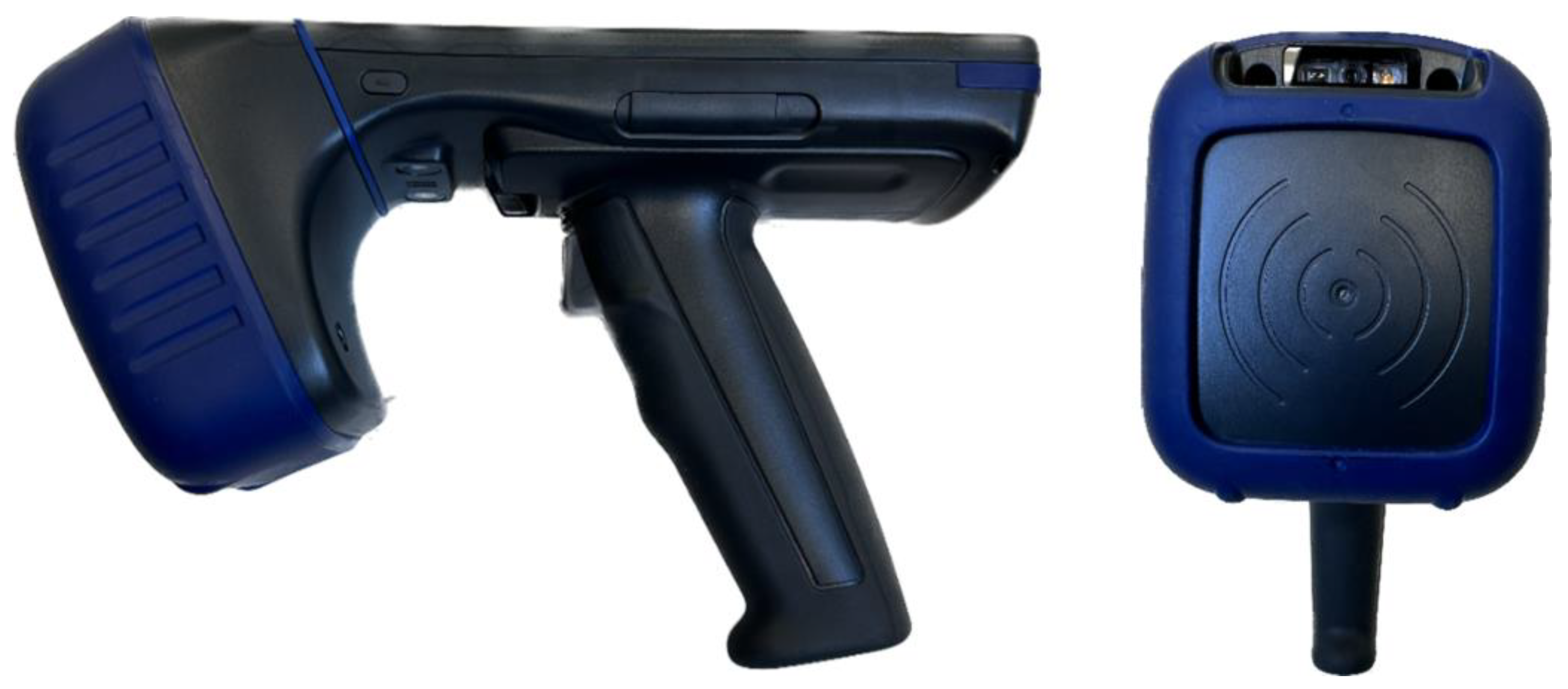
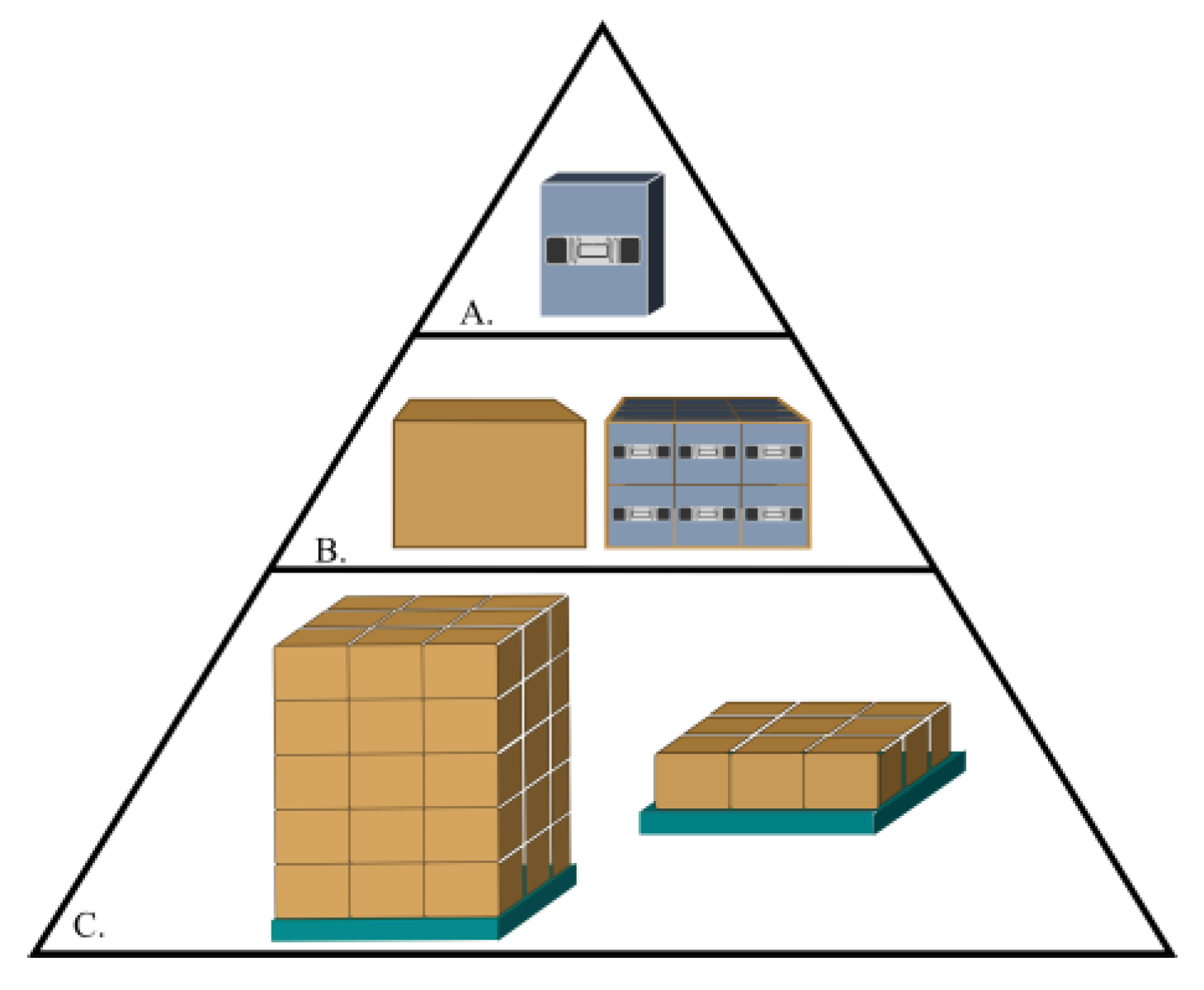
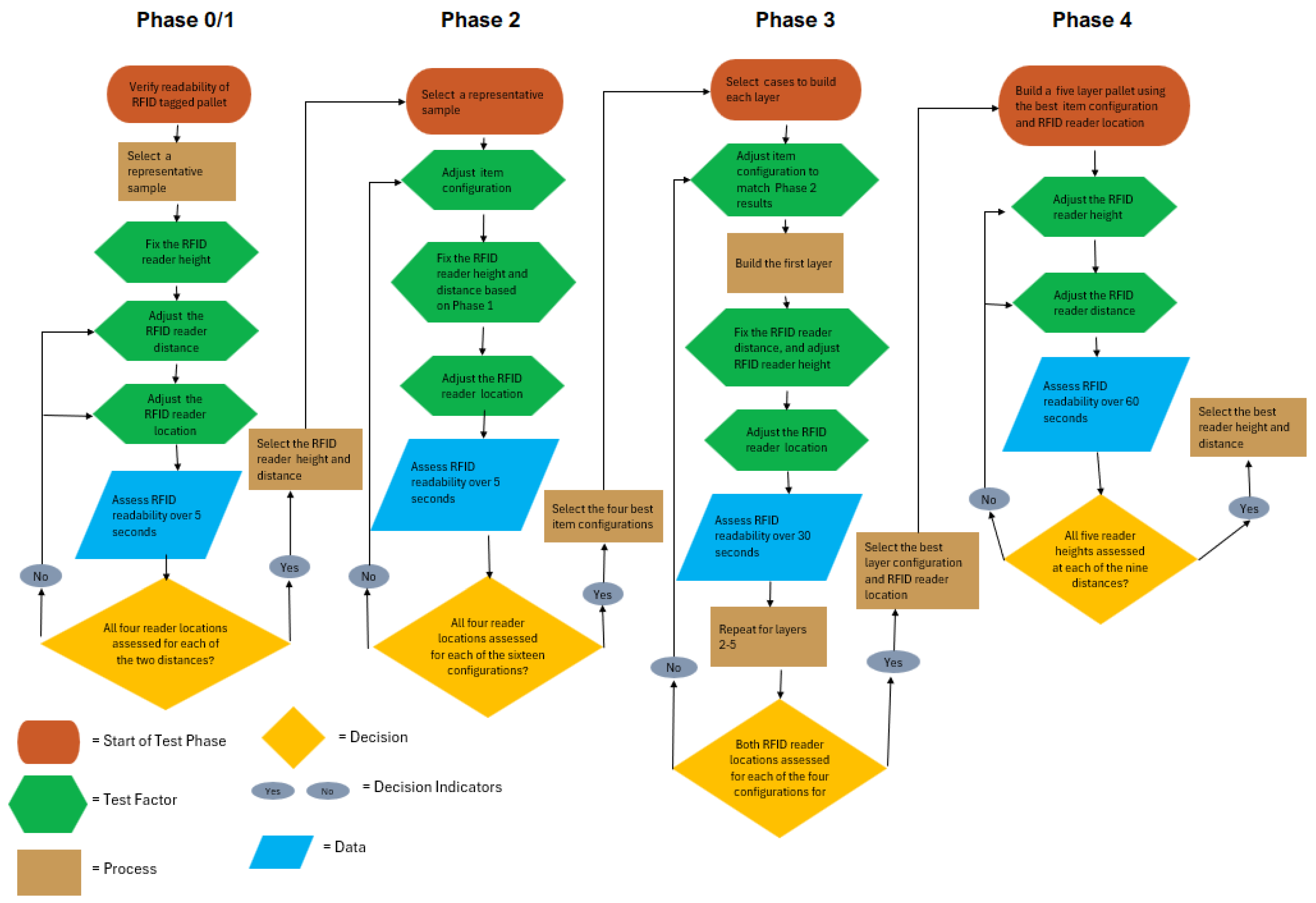



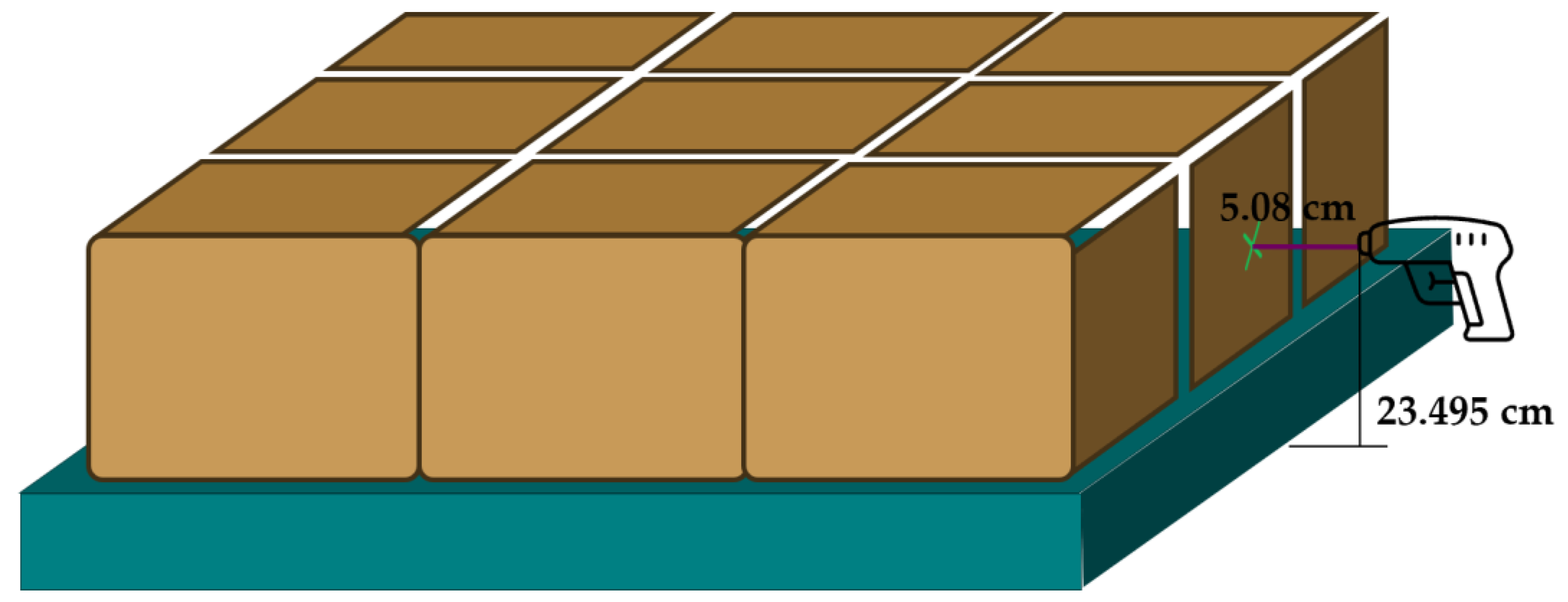
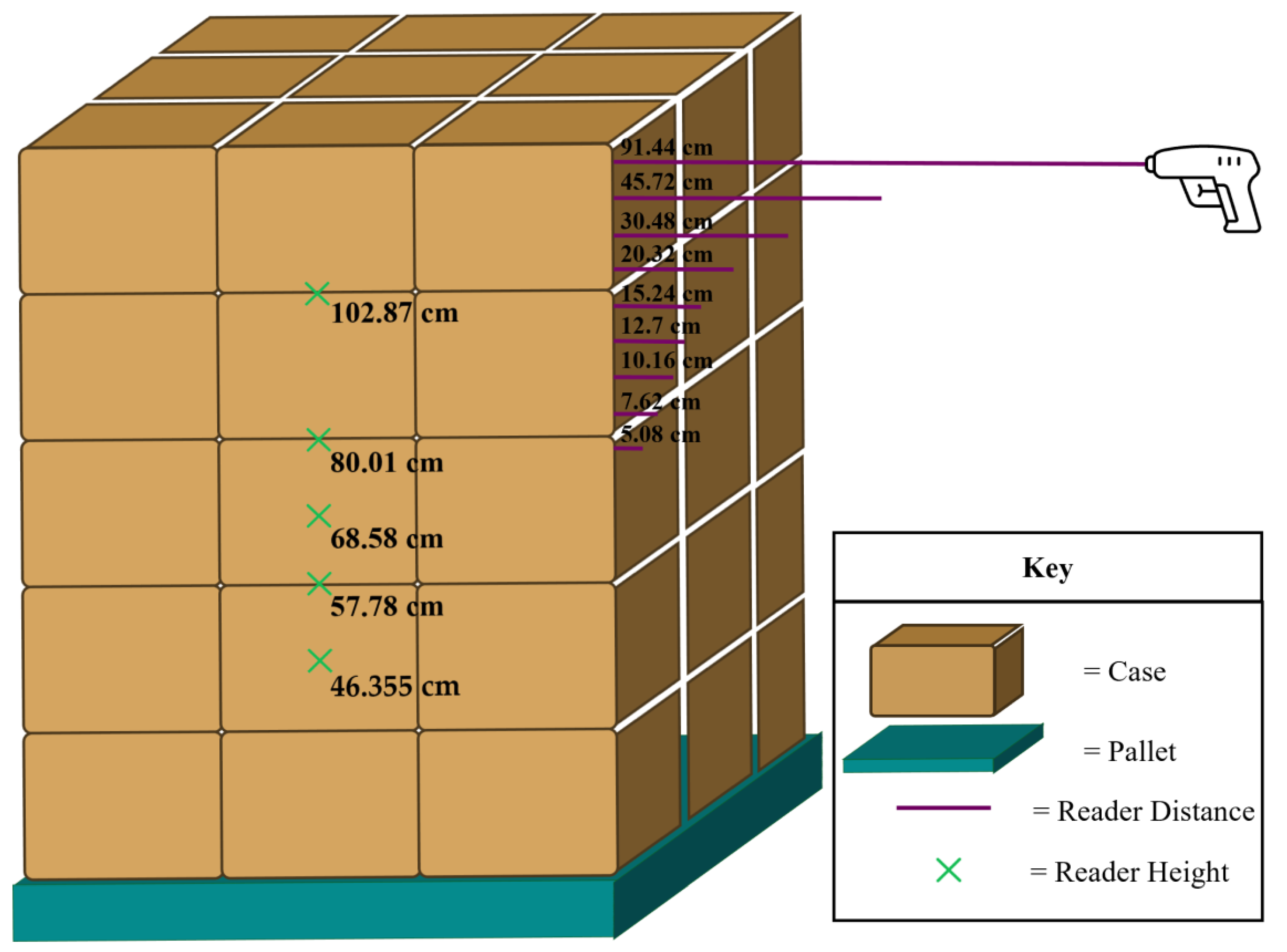

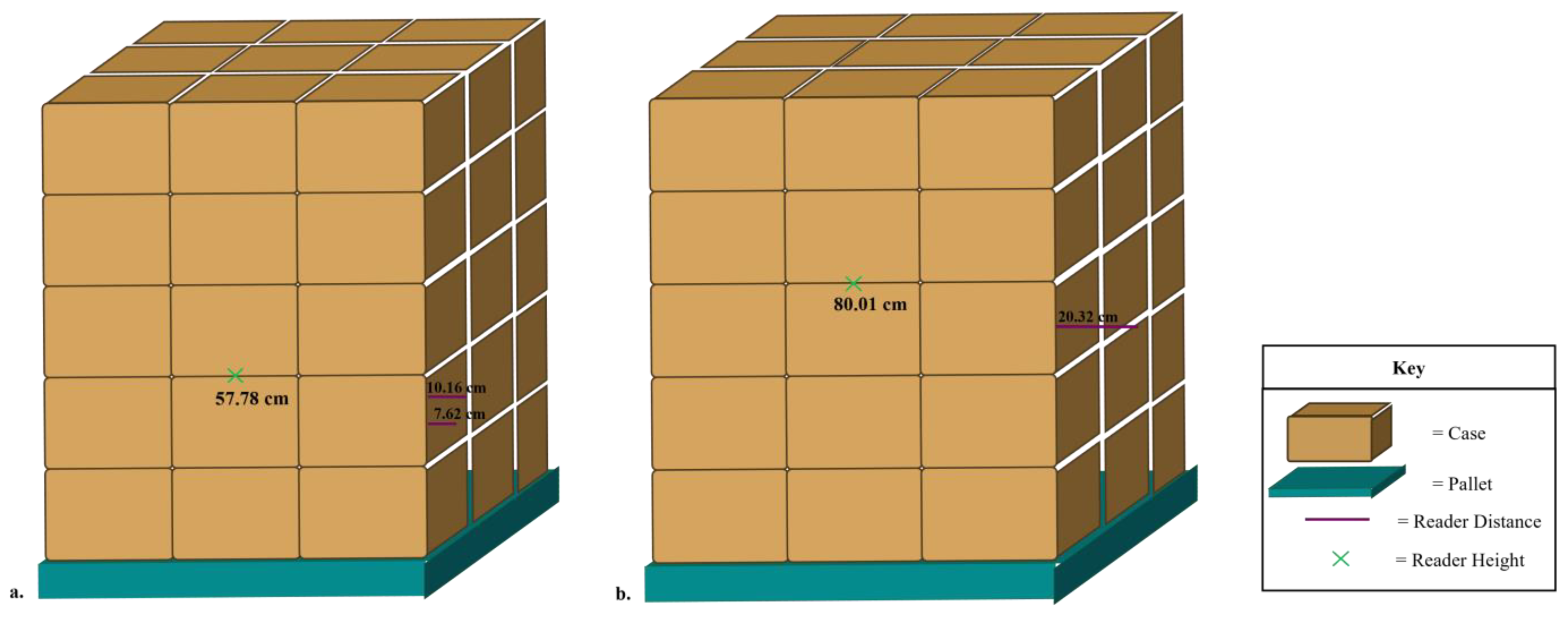
| a | ||
|---|---|---|
| Reader Direction | Tag 1 at 5.08 cm | Tag 1 at 91.44 cm |
| Front | 92.3 ± 4.3 aB | 28.7 ± 6.1 bC |
| Back | 96.7 ± 2.1 aA | 22.2 ± 7.6 bD |
| Left | 91.0 ± 2.0 aB | 43.3 ± 7.3 bA |
| Right | 84.5 ± 7.6 aC | 34.2 ± 9.1 bB |
| b | ||
| Reader Direction | Tag 2 at 5.08 cm | Tag 2 at 91.44 cm |
| Front | 100.0 ± 0.0 aA | 99.2 ± 1.9 bA |
| Back | 100.0 ± 0.0 aA | 68.3 ± 2.3 bC |
| Left | 100.0 ± 0.0 aA | 86.7 ± 1.9 bB |
| Right | 100.0 ± 0.0 aA | 70.0 ± 1.9 bC |
| Case Config. | Read Orientation | Tag 1 | Tag 2 | Case Config. | Read Orientation | Tag 1 | Tag 2 |
|---|---|---|---|---|---|---|---|
| LLL | Front | 93.8 ± 6.6 | 100.0 ± 0.0 | RRL | Front | 96.7 ± 3.8 | 100.0 ± 0.0 |
| Back | 100.0 ± 0.0 | 100.0 ± 0.0 | Back | 96.7 ± 3.8 | 100.0 ± 0.0 | ||
| LLL | Left | 87.9 ± 4.1 | 100.0 ± 0.0 | RRR | Left | 87.1 ± 3.6 | 100.0 ± 0.0 |
| Right | 87.9 ± 8.4 | 100.0 ± 0.0 | Right | 94.2 ± 2.2 | 100.0 ± 0.0 | ||
| RRR | Front | 96.3 ± 4.1 | 100.0 ± 0.0 | LLR | Front | 96.7 ± 3.8 | 100.0 ± 0.0 |
| Back | 96.3 ± 4.6 | 100.0 ± 0.0 | Back | 95.4 ± 5.0 | 100.0 ± 0.0 | ||
| RRR | Left | 89.6 ± 4.5 | 100.0 ± 0.0 | RRR | Left | 90.0 ± 4.0 | 100.0 ± 0.0 |
| Right | 93.3 ± 4.0 | 100.0 ± 0.0 | Right | 88.8 ± 2.8 | 100.0 ± 0.0 | ||
| LLL | Front | 93.8 ± 6.6 | 100.0 ± 0.0 | RRR | Front | 96.3 ± 4.1 | 100.0 ± 0.0 |
| Back | 94.2 ± 6.3 | 100.0 ± 0.0 | Back | 93.3 ± 4.5 | 100.0 ± 0.0 | ||
| RRR | Left | 87.9 ± 3.1 | 100.0 ± 0.0 | RLR | Left | 95.4 ± 5.0 | 100.0 ± 0.0 |
| Right | 81.3 ± 4.5 | 100.0 ± 0.0 | Right | 92.5 ± 5.5 | 100.0 ± 0.0 | ||
| RRR | Front | 97.1 ± 4.0 | 100.0 ± 0.0 | RRR | Front | 93.8 ± 6.6 | 100.0 ± 0.0 |
| Back | 91.3 ± 9.5 | 100.0 ± 0.0 | Back | 97.9 ± 2.2 | 100.0 ± 0.0 | ||
| LLL | Left | 93.8 ± 3.5 | 97.9 ± 0.5 | RRL | Left | 83.3 ± 9.0 | 100.0 ± 0.0 |
| Right | 90.0 ± 2.9 | 100.0 ± 0.0 | Right | 92.9 ± 4.4 | 100.0 ± 0.0 | ||
| LLL | Front | 92.9 ± 2.0 | 100.0 ± 0.0 | RRR | Front | 99.6 ± 1.3 | 100.0 ± 0.0 |
| Back | 95.8 ± 4.4 | 100.0 ± 0.0 | Back | 97.5 ± 2.2 | 100.0 ± 0.0 | ||
| RLR | Left | 85.0 ± 4.0 | 100.0 ± 0.0 | LLR | Left | 88.3 ± 2.6 | 100.0 ± 0.0 |
| Right | 74.2 ± 9.8 | 100.0 ± 0.0 | Right | 90.0 ± 4.0 | 100.0 ± 0.0 | ||
| LLL | Front | 95.8 ± 4.4 | 100.0 ± 0.0 | RLR | Front | 100.0 ± 0.0 | 100.0 ± 0.0 |
| Back | 97.9 ± 2.2 | 100.0 ± 0.0 | Back | 92.9 ± 7.6 | 100.0 ± 0.0 | ||
| RRL | Left | 92.9 ± 4.4 | 100.0 ± 0.0 | LLL | Left | 90.0 ± 5.6 | 100.0 ± 0.0 |
| Right | 80.4 ± 12.0 | 100.0 ± 0.0 | Right | 87.5 ± 3.4 | 100.0 ± 0.0 | ||
| LLL | Front | 91.3 ± 5.0 | 100.0 ± 0.0 | RRL | Front | 95.8 ± 4.4 | 100.0 ± 0.0 |
| Back | 92.1 ± 8.4 | 100.0 ± 0.0 | Back | 95.8 ± 4.4 | 100.0 ± 0.0 | ||
| LLR | Left | 95.8 ± 0.0 | 100.0 ± 0.0 | LLL | Left | 90.4 ± 2.0 | 100.0 ± 0.0 |
| Right | 77.1 ± 8.6 | 100.0 ± 0.0 | Right | 87.9 ± 6.0 | 100.0 ± 0.0 | ||
| RLR | Front | 95.4 ± 5.0 | 100.0 ± 0.0 | LLR | Front | 95.4 ± 3.6 | 100.0 ± 0.0 |
| Back | 90.4 ± 6.8 | 100.0 ± 0.0 | Back | 91.7 ± 8.8 | 100.0 ± 0.0 | ||
| RRR | Left | 91.3 ± 1.3 | 100.0 ± 0.0 | LLL | Left | 90.4 ± 5.9 | 100.0 ± 0.0 |
| Right | 83.8 ± 2.4 | 100.0 ± 0.0 | Right | 86.7 ± 2.6 | 100.0 ± 0.0 |
| a | |||||||||||
|---|---|---|---|---|---|---|---|---|---|---|---|
| Layer 1 | Layer 2 | Layer 3 | Layer 4 | Layer 5 | |||||||
| Case Config. | Reader Direction | Tag 1 | Tag 2 | Tag 1 | Tag 2 | Tag 1 | Tag 2 | Tag 1 | Tag 2 | Tag 1 | Tag 2 |
| RRR | Front | 92.4 ± 0.5 bA | 96.9 ± 0.9 aA | 85.8 ± 0.9 bA | 92.5 ± 0.6 aA | 80.4 ± 0.6 aA | 79.1 ± 1.3 aA | 72.2 ± 0.6 aA | 71.3 ± 0.9 bA | 62.3 ± 0.8 bA | 72.3 ± 0.9 aA |
| RRR | Back | 92.6 ± 0.5 bA | 96.7 ± 1.1 aA | 84.1 ± 0.8 bB | 92.0 ± 1.2 aA | 80.1 ± 0.9 aA | 79.4 ± 1.0 aA | 73.0 ± 1.0 aA | 70.9 ± 1.9 bA | 61.2 ± 3.8 bA | 74.3 ± 0.9 aA |
| LLL | Front | 92.7 ± 0.6 bA | 96.0 ± 0.7 aA | 86.3 ± 0.7 bA | 91.9 ± 0.4 aA | 81.4 ± 0.7 aA | 79.3 ± 0.5 aA | 72.2 ± 1.0 aA | 70.6 ± 2.0 bA | 61.6 ± 2.0 bA | 74.1 ± 0.8 aA |
| LLL | Back | 92.4 ± 0.6 bA | 95.1 ± 0.7 aA | 84.6 ± 1.2 bB | 91.5 ± 0.7 aA | 79.1 ± 1.9 aA | 78.1 ± 1.3 aA | 71.7 ± 1.6 aA | 71.0 ± 1.6 bA | 60.0 ± 2.6 bA | 71.9 ± 1.1 aA |
| b | |||||||||||
| Layer 1 | Layer 2 | Layer 3 | Layer 4 | Layer 5 | |||||||
| Case Config. | Reader Direction | Tag 1 | Tag 2 | Tag 1 | Tag 2 | Tag 1 | Tag 2 | Tag 1 | Tag 2 | Tag 1 | Tag 2 |
| LLL | Front | 89.8 ± 0.4 bA | 96.7 ± 0.6 aA | 86.5 ± 2.2 bA | 91.4 ± 0.6 aA | 79.9 ± 0.5 aA | 78.8 ± 0.3 aA | 72.0 ± 1.2 aA | 72.2 ± 0.7 aA | 61.4 ± 0.8 bA | 69.1 ± 1.3 aA |
| RRR | Back | 92.6 ± 0.5 bA | 96.0 ± 0.5 aA | 83.9 ± 0.9 bB | 91.6 ± 0.5 aA | 76.4 ± 0.6 aA | 78.9 ± 0.5 aA | 71.4 ± 0.7 aA | 72.0 ± 2.1 aA | 59.2 ± 0.6 bA | 69.7 ± 0.7 aA |
| RRR | Front | 93.5 ± 0.4 bA | 95.6 ± 1.3 aA | 86.4 ± 0.4 bA | 91.2 ± 0.5 aA | 77.0 ± 0.7 aA | 78.2 ± 0.7 aA | 71.6 ± 2.5 aA | 71.4 ± 0.7 aA | 63.2 ± 0.7 bA | 70.0 ± 1.3 aA |
| LLL | Back | 92.6 ± 0.2 bA | 95.4 ± 1.5 aA | 84.7 ± 1.1 bB | 91.2 ± 0.6 aA | 76.7 ± 0.8 aA | 78.4 ± 0.6 aA | 72.4 ± 1.3 aA | 72.6 ± 1.3 aA | 61.1 ± 2.4 bA | 69.2 ± 1.2 aA |
| Reader Height (cm) | 46.355 | 57.78 | 68.58 | 80.01 | 102.87 | |||||
|---|---|---|---|---|---|---|---|---|---|---|
| Reader Distance (cm) | Tag 1 | Tag 2 | Tag 1 | Tag 2 | Tag 1 | Tag 2 | Tag 1 | Tag 2 | Tag 1 | Tag 2 |
| 5.08 | 58.2 ± 0.2 b | 71.3 ± 0.9 a | 64.0 ± 0.5 b | 69.1 ± 0.6 a | 61.6 ± 0.3 b | 70.1 ± 0.9 a | 61.8 ± 0.4 b | 72.9 ± 0.5 a | 57.5 ± 0.2 b | 58.7 ± 0.8 a |
| 7.62 | 59.2 ± 0.5 b | 67.9 ± 0.7 a | 64.5 ± 0.3 a | 64.0 ± 0.9 a | 63.6 ± 0.2 a | 64.4 ± 1.0 a | 62.4 ± 0.5 b | 68.8 ± 0.5 a | 59.4 ± 0.4 a | 54.6 ± 0.4 b |
| 10.16 | 59.9 ± 0.8 b | 67.7 ± 0.5 a | 64.5 ± 0.2 b | 65.1 ± 0.5 a | 64.0 ± 0.3 a | 64.5 ± 0.5 a | 62.7 ± 0.5 b | 69.9 ± 0.5 a | 59.1 ± 0.3 a | 57.5 ± 0.9 b |
| 12.7 | 59.7 ± 0.5 b | 68.6 ± 0.4 a | 64.1 ± 1.2 b | 67.8 ± 0.6 a | 64.2 ± 0.4 b | 69.0 ± 0.4 a | 62.5 ± 0.1 b | 69.9 ± 0.8 a | 57.7 ± 0.7 b | 61.8 ± 0.6 a |
| 15.24 | 56.6 ± 0.6 b | 72.3 ± 0.2 a | 62.6 ± 0.4 b | 71.9 ± 0.7 a | 63.7 ± 0.3 b | 75.1 ± 0.6 a | 63.8 ± 0.4 b | 73.7 ± 0.3 a | 56.3 ± 0.4 b | 67.0 ± 0.5 a |
| 20.32 | 54.5 ± 0.3 b | 77.8 ± 0.7 a | 61.4 ± 0.8 b | 73.3 ± 0.7 a | 61.3 ± 0.6 b | 76.0 ± 0.5 a | 64.4 ± 0.4 b | 79.7 ± 0.9 a | 59.8 ± 0.5 b | 71.3 ± 0.9 a |
| 30.48 | N/A | 72.8 ± 0.9 | N/A | 69.6 ± 1.0 | N/A | 76.3 ± 0.9 | N/A | 78.2 ± 0.3 | N/A | 70.5 ± 0.7 |
| 45.72 | N/A | 68.2 ± 0.4 | N/A | 67.5 ± 0.5 | N/A | 69.9 ± 1.2 | N/A | 78.4 ± 0.9 | N/A | 69.2 ± 1.0 |
| 91.44 | N/A | 57.4 ± 0.8 | N/A | 61.6 ± 1.2 | N/A | 59.7 ± 0.9 | N/A | 66.5 ± 0.7 | N/A | 61.1 ± 0.8 |
| Reader Height (cm) | 46.355 | 57.78 | 68.58 | |||
|---|---|---|---|---|---|---|
| Reader Distance (cm) | Tag 1 | Tag 2 | Tag 1 | Tag 2 | Tag 1 | Tag 2 |
| 15.24 | 92.4 ± 0.3 | 92.8 ± 0.6 | 93.6 ± 0.5 | 95.3 ± 0.7 | 89.2 ± 0.3 | 95.4 ± 0.3 |
| 20.32 | N/A | 92.6 ± 0.5 | N/A | 95.3 ± 0.4 | N/A | 95.4 ± 0.7 |
| 30.48 | 88.6 ± 0.8 | 92.5 ± 0.9 | 93.3 ± 0.7 | 95.1 ± 0.4 | 87.4 ± 0.4 | 96.8 ± 0.3 |
| 45.72 | 85.4 ± 0.5 | 94.0 ± 0.6 | 87.1 ± 0.9 | 95.3 ± 0.3 | 83.5 ± 0.2 | 97.8 ± 0.4 |
| 91.44 | 79.3 ± 0.7 | 87.7 ± 0.5 | 77.0 ± 0.7 | 90.1 ± 0.3 | 67.7 ± 0.5 | 89.9 ± 0.9 |
| a | ||
|---|---|---|
| Non-Rotating (Static) Pallet | ||
| Reader Height (cm) | Tag 1 | Tag 2 |
| 46.355 | 65.4 ± 0.3 bC | 67.4 ± 0.7 aC |
| 57.78 | 80.7 ± 0.8 bB | 86.1 ± 1.2 aB |
| 60.325 | 86.9 ± 0.8 bA | 92.7 ± 0.7 aA |
| b | ||
| Rotating Pallet | ||
| Reader Height (cm) | Tag 1 | Tag 2 |
| 46.355 | 90.1 ± 0.8 aC | 90.6 ± 0.3 aC |
| 57.78 | 95.4 ± 0.5 bB | 96.8 ± 0.4 aB |
| 60.325 | 97.7 ± 0.2 bA | 99.7 ± 0.1 aA |
Disclaimer/Publisher’s Note: The statements, opinions and data contained in all publications are solely those of the individual author(s) and contributor(s) and not of MDPI and/or the editor(s). MDPI and/or the editor(s) disclaim responsibility for any injury to people or property resulting from any ideas, methods, instructions or products referred to in the content. |
© 2025 by the authors. Licensee MDPI, Basel, Switzerland. This article is an open access article distributed under the terms and conditions of the Creative Commons Attribution (CC BY) license (https://creativecommons.org/licenses/by/4.0/).
Share and Cite
Claucherty, E.; Cummins, D.; Aliakbarian, B. RFID Unpacked: A Case Study in Employing RFID Tags from Item to Pallet Level. Electronics 2025, 14, 278. https://doi.org/10.3390/electronics14020278
Claucherty E, Cummins D, Aliakbarian B. RFID Unpacked: A Case Study in Employing RFID Tags from Item to Pallet Level. Electronics. 2025; 14(2):278. https://doi.org/10.3390/electronics14020278
Chicago/Turabian StyleClaucherty, Ethan, Danielle Cummins, and Bahar Aliakbarian. 2025. "RFID Unpacked: A Case Study in Employing RFID Tags from Item to Pallet Level" Electronics 14, no. 2: 278. https://doi.org/10.3390/electronics14020278
APA StyleClaucherty, E., Cummins, D., & Aliakbarian, B. (2025). RFID Unpacked: A Case Study in Employing RFID Tags from Item to Pallet Level. Electronics, 14(2), 278. https://doi.org/10.3390/electronics14020278








